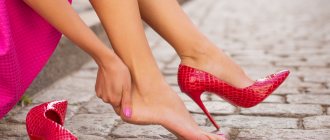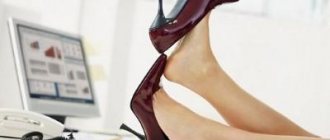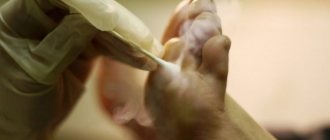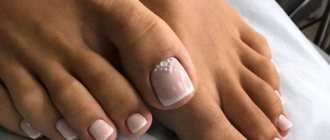Foot skin problems can be solved by a pedicurist or a qualified podiatrist. The skin is the largest and most vulnerable organ. Covers are constantly in contact with an aggressive environment and are exposed to mechanical and chemical influences. The body takes this into account and skin regeneration is one of the fastest processes.
We must help our body with proper care, nutrition, and hydration. Unfortunately, not everyone thinks about the importance of regular and competent care. The result is skin problems. Let's look at what problems there are and how to fix them.
Every day, feet are exposed to constant high loads. This is aggravated by the use of low-quality, incorrect and restrictive shoes and socks made of synthetic fabrics. As a result, foot skin pathologies occur in the majority of the population. An indifferent attitude towards cracked heels, dry and wet calluses, and regular peeling of the skin can lead to serious chronic diseases.
Many foot skin problems can be eliminated by a podiatrist. He will provide proper care, treatment of the skin, its hydration and nutrition, and give recommendations for prevention at home. If you do not use the services of a podiatrist in a timely manner, then in the future you will need the help of a surgeon - do not complicate the situation, take preventive measures in a timely manner.
Main skin problems on the feet
A podiatrist is regularly contacted with the following foot skin pathologies:
- calluses;
- cracks of different depths;
- dry skin;
- hyperhidrosis;
- corns;
- hyperkeratosis.
The specialist’s task is not only to identify the presence of pathology and select a method for eliminating it, but also to determine the causes of its occurrence - this will help carry out prevention and prevent the occurrence of pathologies in the future.
Callus or wart?
A wart is a small growth that is caused by the human papillomavirus (HPV). Calluses and warts may be similar in appearance. A wart can be distinguished by its more granular structure and location (warts can appear on any part of the body). To accurately make a diagnosis (callus or wart) and select treatment, the surgeon can conduct a dermoscopic examination and additionally prescribe a test for human papillomavirus (HPV).
What are foot cracks?
Cracks in the epidermal layer appear on the outer skin and can extend deep into the dermis. Heels are a typical localization area.
Main causes of cracks
- leg injuries and mechanical damage;
- improperly performed pedicure;
- lack of regular skin care;
- dry skin;
- diseases of the digestive system;
- past fungal diseases;
- diabetes;
- taking antibiotics;
- psoriasis;
- dehydration of the body;
- strict diet without supervision by specialists;
- thyroid disease;
- hormonal changes, taking hormonal medications.
The appearance of cracks in the legs can be seasonal or chronic.
A pedicurist will be able to cope with cracks, but an integrated approach requires the help of an endocrinologist, dermatologist, gastoenterologist or immunologist. The master recommends specialists from whom you can get advice.
According to statistics, 70% of cracks are infected with fungi. It is recommended to visit a dermatologist, do tests and identify the type of fungus. This will help you choose a course of treatment for quick and safe skin recovery.
The specificity of fungal cracks is a green or brown tint. A pedicurist immediately sends a client with such a pathology to dermatologists. It is not possible to cure the infection yourself without determining the type of fungus at home. The help of a cosmetologist will not help either - removing the area without an integrated approach can lead to the spread of the disease.
Timely diagnosis
Treatment and diagnosis of growths must be carried out in a timely manner. Otherwise, various complications may occur. The development of an infectious process at the site of callus formation is diagnosed.
If pain, redness and swelling occur, it is recommended to consult a doctor, as this indicates the development of an infection.
If the pathology is not treated in a timely manner, infection may develop in the surrounding tissues. If the patient has diabetes or blood diseases, this can lead to rapid infection of the entire body.
Formations, in accordance with the characteristics of their appearance, are divided into several types. Regardless of this, it is recommended to treat the formations in a timely manner, which will eliminate the possibility of complications.
Treatment of cracks during pedicure
Hardware dry and combined pedicures work well with cracks. To eliminate pathologies, it is not recommended to carry out intensive softening by wetting. With deep tears, it is difficult to work with skin that has collected water.
Deep cracks are removed in 3-7 sessions. The procedure necessarily ends with treatment with nutritional compositions and healing agents. The client is given recommendations for care and, if necessary, demonstrated care procedures.
Main stages
treatment of cracks during combined pedicure:
- Treatment with antiseptic compounds.
- Treatment with keratolics, which contain enzymes and urea.
- The treated area is covered with a napkin for 5-10 minutes.
- Hardware processing with cutters of different hardness. Recommended tips are 100, 150 and 280 grit.
- Processing with a diamond cutter - the master forms a truncated cone in the direction of the crack. This helps open the crack and remove dry edges.
- Removing dust from feet using antiseptic compounds.
- Application of urea or wax based compounds that promote rapid healing.
During a pedicure, the area of skin affected by hyperkeratosis is usually removed.
At home, to increase the rate of acceleration, cracks are treated overnight with wax-based products. During the day, feet are regularly moisturized with nourishing creams. If wax-based products are not available, you can use Vaseline. To improve effectiveness, after treatment overnight, the cracks are covered with polyethylene and a cotton sock is put on.
Calluses: causes and methods of removal
A callus is formed by compaction of dead skin cells. They are distinguished by strictly defined and clearly visible boundaries, and can be dry or wet.
The main reasons for the formation of calluses:
- wearing uncomfortable and tight shoes;
- hard backs of shoes;
- wearing shoes without socks;
- irregular foot skin care;
- foot deformity;
- lack of care procedures.
Most calluses cause pain, discomfort, and are a source of infection.
Core calluses cannot be eliminated at home; a visit to a podiatrist is necessary. The pathology forms in the area of the fingers or foot and has a deep, pinpoint root canal. These calluses are often affected by fungus.
Effective elimination is only possible with an understanding of the cause of the formation. Dry calluses are removed by a pedicurist, who pre-soaks the skin and removes the growth with a nail file. Wet calluses require an exclusively individual approach.
Traditional medicine in the treatment of calluses
Folk remedies cannot affect the development of callus and are not an effective treatment method.
The treatment and removal of callus must be carried out by a qualified specialist.
This will minimize negative consequences and complications.
It is necessary to begin treatment of callus in the early stages of its development.
When there is still a chance to get rid of the problem without resorting to surgical methods.
As it progresses, the root of the callus will penetrate into the deeper layers of the epidermis.
Then it may be necessary to use more radical and expensive methods of therapy.
Corns: features and treatment
Corns resemble calluses, but are irregular in shape, large in size, have jagged edges, and are highly dense. The main means of combating corns is a combined pedicure. Cosmetologists use keratolic agents, which have a softening effect, and devices with attachments of varying degrees of abrasiveness.
The main causes of corns:
- low-quality, uncomfortable shoes;
- foot deformity;
- improper regeneration of the skin of the foot;
- dehydration and strict diets.
The regular appearance of corns, regardless of the shoes used, is a reason to visit an orthopedist.
The main stages of eliminating corns:
- visiting a pedicurist who will file the damaged area. The procedure is performed in several stages;
- daily home care;
- wearing shoes with orthopedic insoles;
- scheduled visit to a podiatrist.
With the help of a hardware pedicure, you can remove a small corn in one session. Large and dense ones are removed gradually, since if a significant area is removed in one procedure, the regeneration process is activated and the corns increase in size.
2. Reasons
The immediate cause of the formation of calluses on the skin is a local mechanical effect, stereotypical in nature (repeated friction, vibrating pressure, etc.). If in a given area the combination of intensity and duration of such exposure exceeds a certain threshold of strength, stability, and density of the skin, the cellular layers are damaged, regenerative mechanisms do not have time to restore the tissue, and certain pathological changes begin in it, which, again, depend on the strength , duration and vectors of mechanical irritation.
With strong friction, unusual for any area, a callus can form and spontaneously open in a matter of minutes; on the contrary, with soft, almost imperceptible, but constant pressure and rubbing, years may pass until the skin thickens and hardens adequately to the impact. In general, the adaptive capabilities of skin tissue are very great: it can adapt (hardening, as they say, to stone hardness) even to oars, a shovel or a heavy lumberjack axe.
The most typical origin of calluses is working with hand tools and equipment, playing musical instruments (especially stringed ones), and regular training on sports equipment. An extensive and diverse group is also formed by calluses associated with shoes: improperly selected, tight or too loose shoes that do not correspond to individual orthopedic features (flat feet, high instep, joint inflammation, etc.), rough and simply poorly cut and sewn shoes can become cause serious problems.
Visit our Therapy page
What is hyperhidrosis
Hyperhidrosis is increased sweating, which leads to the formation of skin pathologies. An area with constant high humidity and a temperature comfortable for the growth of bacteria is created in the foot area. This causes an unpleasant odor and peeling of the skin in large areas.
The main reasons for the development of hyperhidrosis:
- disorders of the thyroid gland;
- wearing uncomfortable shoes with poor ventilation;
- the use of low-quality creams based on synthetic bases that form an airtight film on the surface of the skin.
The main problem with hyperhidrosis is thick and swollen skin. It is difficult to process using hardware methods. To relieve the main symptoms, it is recommended to sprinkle the damaged areas with baby powder or talcum powder.
To treat hyperhidrosis, alcohol-based antiseptic formulations are used. The treatment can be done in a beauty salon. After hygienic treatment, the feet are wiped and treated with talcum powder. Prepared feet are processed using hardware methods using cutters with a hardness of 100-280 grit. After completing the procedure, the master will definitely give recommendations.
General recommendations:
- use a deodorant recommended by a specialist;
- wear shoes and clothes made from natural materials;
- take good care of your shoes;
- Perform regular foot hygiene procedures at least twice a day.
- Pay special attention to the condition of the insoles.
A callus is a minor detail with significant consequences.
The foot also needs attention
“Just think! Callus or discomfort when walking. I’ll come home, put on my favorite slippers and everything will be fine. But it’s not that simple, unfortunately.” Any of our wrong actions (or inactions) sooner or later lead to consequences.
The human foot is analogous to a shock absorber in a car. The longitudinal and transverse arches allow you to counteract the pressure when walking. Since childhood, our foot, its mobility, and the tendon-muscle complex require training. By paying attention to this in time, we will get healthy and strong legs for many years. But this is all in theory, which is often very far from practice.
Usually, an orthopedic doctor sees a much larger number of problems in his patients who come in with a callus that no longer allows them to walk calmly. And there is a deformation of the big toe, and on the flat (and a healthy foot is always concave) sole there is a red, rough callus, with the skin very painful when touched, both on it and around it. X-rays will only confirm the obvious diagnosis – flat feet with calluses.
A problem from time immemorial
Since ancient times, people have been walking a lot in our area. At first barefoot and in bast shoes, with the passage of time “changing shoes” into boots and felt boots. But from the “window to Europe”, cut by Peter the Great, came the Parisian fashion for shoes, wigs, and colorful clothes. But the rules of hygiene both in St. Petersburg and Paris appeared later. Therefore, no one even thought about washing their feet every day. There were, of course, exceptions to the rules. But even for such people, external gloss and pathos played a much greater role than the cleanliness of their legs.
And the tradition of the Russian bathhouse came to naught. Running barefoot through the snow for a while, then putting on soft boots after that... More and more, this has become some kind of curiosity, and not a weekly everyday ritual of our people.
Customized shoes
We have all read the wonderful fairy tale “Cinderella”, where the events revolved around the Crystal Slipper. As we remember, only one Cinderella was suitable for these outlandish shoes. Fairy Godmother made it “custom-made” for her, taking into account her leg. But this is still a fairy tale, and the reality is much less magical. Therefore, our women (no doubt, they are still as beautiful as Cinderella, but...) have to put on their long-suffering feet rigid designs with impressive heels, which do not take into account the characteristics of their feet, instep, toes, and heels. As a result, the position and relief of the foot are disrupted.
If you walk barefoot, the load is evenly distributed between the heel area and the base of the toes. The arches of the feet are also correctly included in the work, which thereby perform their main shock-absorbing function. And in current shoes, and especially high-heeled shoes, the main load falls on the metatarsophalangeal joints (the base of the fingers). Nature did not provide for this. And when walking, the joints become deformed, experience a load they were not designed to bear, and the foot “straightens.” Calluses appear, which quickly “acquire” a mucous membrane. It is she, although hidden from view, that causes pain. And in the future it may well become inflamed and fester. Now, if every woman could afford shoes made of soft leather with low, stable heels with a well-thought-out internal relief, then there would be significantly fewer orthopedic patients.
Our feet are worth taking care of.
If you didn’t know what foot deformity is and what the consequences of this phenomenon are, follow our advice. After all, you don’t want to look for advice on how to deal with calluses that have already appeared?
First of all, you can go back to basics and walk barefoot more. Naturally, if you come to work barefoot, they won’t understand this, but at home you can easily afford it. Also, before going to bed, wash your feet with cool water and rub your feet with a slight massage. Terry or canvas towels are perfect for this. If you spend the evening in a stationary environment at the computer or watching TV, then get some kind of rolling pin massager and roll it with the arch of your foot. Also, do not forget to stretch and train the muscles and joints of your legs. To do this, take a few minutes and just walk alternately on your heel and on your toes. All these procedures are absolutely not complicated, take a minimum of time and provide maximum benefits.
If it’s too late to perform these exercises, and flat feet and corns have already entered your life, then do not despair and follow the following recommendations. First of all, you need to give up uncomfortable shoes. Yes, it may not be as beautiful as you are used to, but something will have to be sacrificed. And let this victim not be your feet. Make sure that the shoes have orthopedic insoles and arch supports, or, in extreme cases, line the insole with foam rubber. You can cut a hole in it under the callus, reduce the pressure on it when walking, thereby relieving pain and reducing irritation of this area with subsequent aggravation of the problem. Well, use anti-callus plasters and bath liquids.
Perhaps this will allow you to avoid surgical methods for treating deformed feet.
This is always a difficult option to try to avoid. Conservative methods should not be neglected. But only after consulting a specialized doctor. Do not neglect inflammatory processes on the foot. They are quite dangerous. Also, increased attention to these problems should be paid to older people, diabetics and overweight people. This is a kind of “risk group” that is more likely to encounter complications than others. Author: K.M.N., Academician of the Russian Academy of Medical Sciences M.A. Bobyr
Hyperkeratosis, dryness and flaking
Hyperkeratosis is a thickening of the stratum corneum. A layer of 1 to 10 mm is formed on the feet. The thickening is aggravated by the appearance of cracks, chronic formation of calluses and corns.
Excess weight, poor hygiene and the use of shoes made of synthetic materials are the main triggers of hyperkeratosis, among other reasons:
- genetic factor;
- age-related changes in the body;
- fungal infection;
- improper care of the skin of the feet;
- disturbances in the functioning of the endocrine system.
You can remove the effects of hyperkeratosis in a beauty salon. The pedicurist uses a combined technique, which includes the use of softeners and hardware treatment.
The maximum effect when removing rough skin is achieved when using cutters with an abrasiveness of 100-280 grit. The master gradually reduces the abrasiveness using different attachments.
Recommendations:
- using comfortable shoes;
- regular foot care with moisturizing creams;
- use of socks and shoes made from natural materials;
- regular visits to the podiatrist.
To combat dryness and flaking of the skin, urea-based products are used. The beauty parlors offer a procedure called cold paraffin therapy. A good effect is achieved by using wax applications and nourishing masks.
It is important not only to eliminate a cosmetic defect, but also to identify the causes of its occurrence and ensure proper prevention. If necessary, the podiatrist will give recommendations and refer you for consultations to specialized specialists to identify the cause of the defect.
Avoid serious problems
A wide range of dermatoses develops in patients with diabetes mellitus. A number of pathologies are harbingers of this disease, others are a consequence. In total, up to 30 types of dermatoses with different clinical pictures are registered in diabetes mellitus.
All of the above diseases require professional and long-term treatment. It is recommended not to let your feet get into a condition that would require going to a hospital or clinic. It is necessary to regularly engage in the prevention of foot skin diseases. To do this you need:
- take care of your feet using products recommended by a cosmetologist;
- keep feet clean and dry;
- wipe the skin between the toes well after hygiene procedures;
- change socks twice a day, do not use synthetic shoes;
- wear only personal items.
People with chronic diseases are recommended to visit a podiatrist once every six months to receive professional care procedures.
Types of dressing materials
You need to choose a patch for calluses on your hands and feet taking into account the type and degree of skin damage, the purpose and composition of the impregnation. A properly selected dressing heals the wound, protects it from pathogenic microorganisms, cleanses and disinfects the skin, and promotes healing.
Manufacturers produce silicone, salicylic and liquid patches. The first ones are made of silicone gel, glued to any area of the body, and are invisible when worn. The latter contain salicylic acid, which softens the rough layer of skin. In addition, such a callus plaster for core calluses has an antiseptic and antibacterial effect. Liquid products are compositions that form a protective film on the damaged area. It does not interfere with air exchange and accelerates healing.










